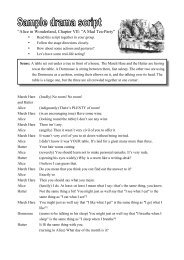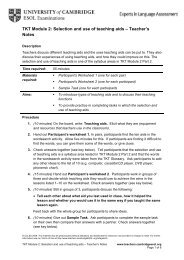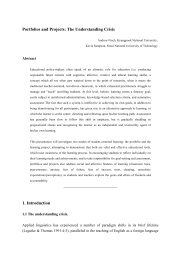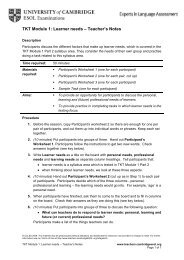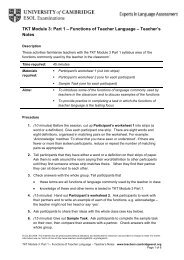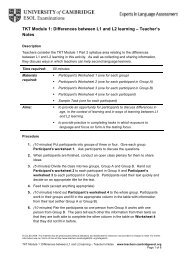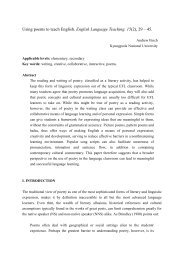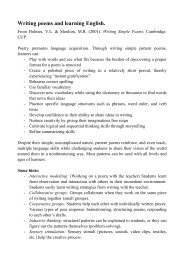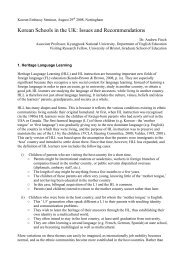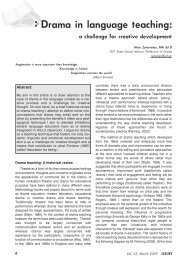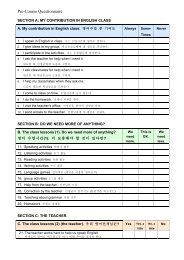Identifying and selecting lesson aims - Finchpark
Identifying and selecting lesson aims - Finchpark
Identifying and selecting lesson aims - Finchpark
You also want an ePaper? Increase the reach of your titles
YUMPU automatically turns print PDFs into web optimized ePapers that Google loves.
TKT Module 2: <strong>Identifying</strong> the different components of a <strong>lesson</strong><br />
plan – Participant’s Worksheet 1<br />
Match the <strong>lesson</strong> plan components with the descriptions below.<br />
1. Procedure 2. Interaction pattern 3. Timetable fit 4. Stage<br />
5. Main aim 6. Timing 7. Aids 8. Assumptions<br />
9. Personal aim 10. Anticipated problems <strong>and</strong> solutions 11. Subsidiary aim<br />
A. The most important aim, e.g. the teacher’s main aim could be to teach the present<br />
perfect or develop listening skills.<br />
B. What the teacher would like to improve on in his/her teaching, e.g. To reduce the time I spend<br />
writing on the whiteboard.<br />
C. The details of exactly what is going to happen in each stage of a <strong>lesson</strong>, e.g. students<br />
practise the language of complaints in a role-play in pairs.<br />
D. A section of a <strong>lesson</strong>. Lessons work through different steps such as lead-in,<br />
presentation, controlled practice, etc.<br />
E. When teachers plan <strong>lesson</strong>s, they think about how long each activity will take <strong>and</strong> they<br />
usually write this on their plan.<br />
F. The things that a teacher uses in a class, e.g. h<strong>and</strong>outs, pictures, flashcards. When<br />
teachers plan <strong>lesson</strong>s they think about what things they will need.<br />
G. When teachers are planning a <strong>lesson</strong>, they think about what their students might find<br />
difficult about the language or skills in the <strong>lesson</strong> so that they can help them learn more<br />
effectively at certain points in the <strong>lesson</strong>.<br />
H. When teachers think about what they believe their students will know or how they will<br />
behave in a particular <strong>lesson</strong>.<br />
I. The different ways students <strong>and</strong> the teacher work together in class, e.g. student to<br />
student, in pairs or groups or teacher to student, in open class.<br />
J. How a <strong>lesson</strong> fits logically into a sequence of <strong>lesson</strong>s; what goes before a particular<br />
<strong>lesson</strong>, how a <strong>lesson</strong> links to, <strong>and</strong> helps students with, the following <strong>lesson</strong>.<br />
K. The secondary focus of the <strong>lesson</strong>, less important then the main aim. It could be the<br />
language or skills learners must be able to use in order to achieve the main aim.<br />
© UCLES 2009. This material may be photocopied (without alteration) <strong>and</strong> distributed for classroom use provided no charge is made. For further<br />
information see our Terms of Use at http://www.teachers.cambridgeESOL.org/ts/legalinfo<br />
TKT Module 2: <strong>Identifying</strong> the different components of a <strong>lesson</strong> plan – Participant’s Worksheet 1<br />
www.teachers.cambridgeesol.org<br />
Page 4 of 7



